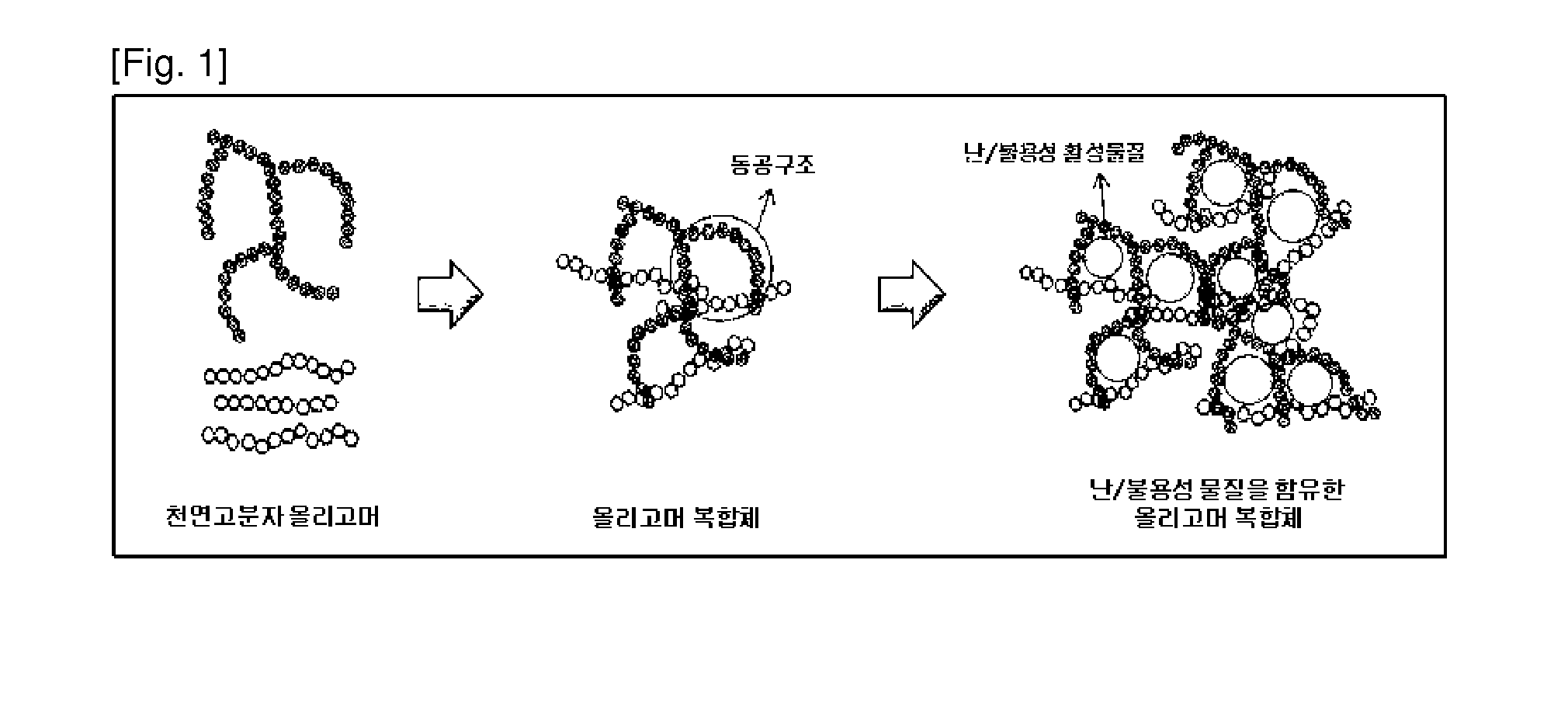Method of solubilizing poorly soluble/insoluble active material through formation of oligomer composite
a technology of poorly soluble/insoluble active materials and composites, which is applied in the directions of ginkgophyta medical ingredients, plant/algae/fungi/lichens ingredients, medical preparations, etc., can solve the problems of unstable natural ingredients, and achieve the effect of increasing the thermodynamic stability and effectively solubilizing the poorly soluble/insoluble material
- Summary
- Abstract
- Description
- Claims
- Application Information
AI Technical Summary
Benefits of technology
Problems solved by technology
Method used
Image
Examples
examples 1 to 120
Application of Oligomer Derived from Natural Polymer
[0034]Two types of natural polymer oligomers were mixed and added to 156 g of distilled water according to a ratio of the following Tables 3 to 5. A reaction temperature was maintained in a range of 40° C. to 50° C., a pH was maintained in a range of 5 to 8 by using a pH adjuster, and an oligomer composite solution was formed by stirring until the oligomers were completely dissolved.
[0035]Temperature and pH of the formed oligomer composite solution were maintained in ranges of 40° C. to 50° C. and 6.5 to 7.5, respectively. An ellagic acid was used as a representative poorly soluble / insoluble material and a predetermined amount of the ellagic acid was slowly added to the oligomer composite solution. The ellagic acid was mixed and stirred within a temperature range of 40° C. to 50° C. At this time, the pH was maintained in a range of 6.5 to 7.5 to allow the ellagic acid to be encapsulated in the hydrophobic cavity structure of the ol...
examples 121 to 138
Preparation of Oligomer Composite Containing Poorly Soluble / Insoluble Material
[0036]Dextrin and maltodextrin among natural polymer oligomers were added to distilled water according to a constant ratio as in the following Table 6. A reaction temperature was maintained in a range of 40° C. to 50° C., a pH was maintained in a range of 5 to 8 by using a pH adjuster, and an oligomer composite solution was formed by being stirred until the dextrin and maltodextrin were completely dissolved. The temperature and pH of the formed oligomer composite solution were maintained in ranges of 40° C. to 50° C. and 6.5 to 7.5, respectively. A predetermined amount of a poorly soluble / insoluble material was simply added to the oligomer composite solution or dissolved in an organic solvent to obtain a concentration of 1% to 50% and then the mixture was slowly added to the oligomer composite solution so as to allow the poorly soluble / insoluble material to be encapsulated in a hydrophobic cavity structure...
PUM
| Property | Measurement | Unit |
|---|---|---|
| temperature | aaaaa | aaaaa |
| temperature | aaaaa | aaaaa |
| temperature | aaaaa | aaaaa |
Abstract
Description
Claims
Application Information
 Login to View More
Login to View More - R&D
- Intellectual Property
- Life Sciences
- Materials
- Tech Scout
- Unparalleled Data Quality
- Higher Quality Content
- 60% Fewer Hallucinations
Browse by: Latest US Patents, China's latest patents, Technical Efficacy Thesaurus, Application Domain, Technology Topic, Popular Technical Reports.
© 2025 PatSnap. All rights reserved.Legal|Privacy policy|Modern Slavery Act Transparency Statement|Sitemap|About US| Contact US: help@patsnap.com


